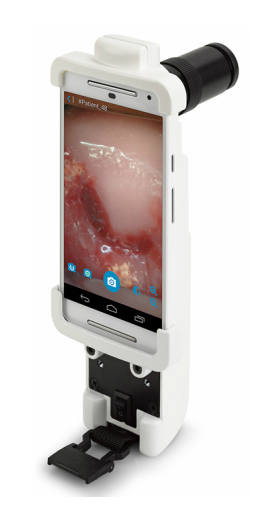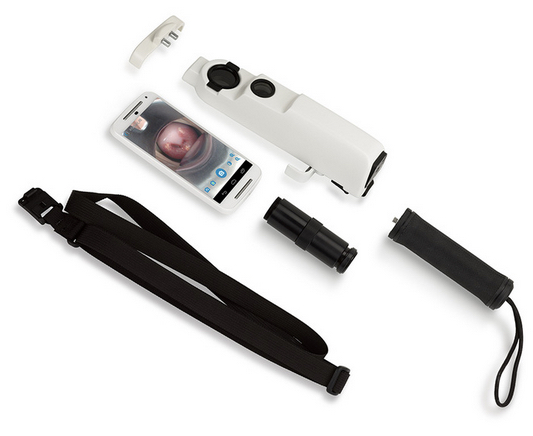Cervical cancer kills one woman every two minutes around the globe. In the developed world, women aged 20 to 60 typically undergo routine or at least periodic cervical cancer screening by a gynecologist or gynecological clinic, and cervical cancer rates having been dramatically reduced in the last 60 years thanks to routine screening with Papanicolau (Pap) smears. American Association of Family Physicians (AAFP) metrics indicate that approximately 55 million women per year have Pap Smears in the US, with approximately 4 million abnormal Pap results detected and the patient advancing to a Colposcopy procedure, in which the cervix is imaged.
However, that level of screening for cervical cancer isn’t available to most women globally. The World Health Organization estimates that 85 percent of women worldwide do not have adequate access to cervical cancer screening, a diagnostic deficiency that leads to some 275,000 out of 527,000 women diagnosed with cervical cancer every year succumbing to the disease – a particular tragedy given that cervical cancer takes 20 years to develop, and can be treated for less than $28 and in less than 40 minutes if caught in the first five years of onset.
The Tel Aviv, Israel based startup firm MobileODT, launched byAriel Beery and David Levitz in 2012, develops and manufactures a relatively inexpensive and portable diagnostic tool for detecting cervical cancer, notes that great work is being done by a non-governmental organizations, such as founding members of Cervical Cancer Action, to highlight the cervical cancer challenge, and the company believes their technology can build on this impressive policy focus to enable better, more reliable tools to empower community health workers currently screening with relatively primitive methods such as Visual Inspection with Acetic Acid (VIA) that will vastly improve the positive predictive value of in-the-field diagnosis to reduce cervical cancer mortality.
MobileODT affirms its mission as delivery of affordable, practical healthcare innovation that can make a difference in the world through creation of innovative optical diagnostic devices and software services focused on early cancer detection and, soon, a range of other medical purposes. A priority is to make these devices available at a cost (approximately $1,800, or $800 apiece in batches of five or more) that enables rapid uptake and wide utilization everywhere, but particularly in low-resource settings, where the need is most acute and the impact can be immediate.
 MobileODT’s disruptive technologies, which won the Vodafone Americas Foundation 2014 Wireless Innovation Project and the 2015 MedTech Innovator competition leverage the ubiquity and native capability of smartphones to do something that’s never been done before: replace complex and cost-prohibitive systems with simplicity and affordability. The company creates advanced optical technology components that turn smartphones into a mobile, easy-to-use point-of-care tools to help detect cancer and capture a range of biomedical images for diagnostic and other analytical purposes.
MobileODT’s disruptive technologies, which won the Vodafone Americas Foundation 2014 Wireless Innovation Project and the 2015 MedTech Innovator competition leverage the ubiquity and native capability of smartphones to do something that’s never been done before: replace complex and cost-prohibitive systems with simplicity and affordability. The company creates advanced optical technology components that turn smartphones into a mobile, easy-to-use point-of-care tools to help detect cancer and capture a range of biomedical images for diagnostic and other analytical purposes.
The company’s Mobile Colposcope device attaches to a mobile phone (currently only compatible with Google’s Android operating system) and is held some 15 centimetres away from the patient’s body with images from the scan relayed to a mobile app for interpretation. MobileODT have developed app-based programs with which to operate their devices and connect to a cloud-based software platform that enables capabilities that couldn’t be have been imagined just a few years ago — from immediate remote expert consultations to improved case management, and, importantly — to easy integration with the range of emerging electronic health records programs.
If a Mobile Colposcope scan detects anomalies or abnormalities, the patient can then be referred for a biopsy and timely treatment.
MobileODT is pioneering new approaches to diagnostics and disease management while staying directly in the current of emerging technology, and dedicated to products and platforms that address three critical fronts:
1) Make an immediate impact on patient health in challenging settings
2) Can be quickly adopted into practice through easy integration into clinical protocols and a low threshold of healthcare worker training
3) Can be seamlessly integrated into a range of existing and emerging digital healthcare management systems
MobileODT’s technology is a potentially game-changing solution to reduce cervical cancer, a global health priority that requires approximately 700 million screenings per year. They report that their Cervical Cancer Screening System has met with enthusiastic response in pilot markets around the world including Haiti, Guatemala, Botswana, Kenya, Nepal, Mexico, and the United States.
“Our device is most popular in low resource settings such as Kenya because there is no need for specialized care in interpreting the images,” Mobile ODT’s head of partnership Curtis Peterson, told Business Daily (Kenya)’s Verah Okeyo. “Kenya has really embraced technology and there is therefore no reason why this same technology should not be used to change healthcare especially of poor citizens.”
MobileODT has worked in close partnership with leading organizations and medical institutions in 14 countries, including Partners In Health, the Center for Global Health at Massachusetts General Hospital, the Botswana-UPenn Partnership, PROSALUD, and the Scripps Medical Center, and they say there’s much more to come.
“I’ve been working with women with cervical cancer for more than 20 years,” comments Bruce Kahn, MD, Department of Ob/Gyn, Scripps Clinic “This technology may be a real breakthrough in the diagnosis in pre-cancerous changes, not only in the developing world… This could actually replace Pap smear testing.”
MobileODT predicts that their device will revolutionize colposcopy and cervical cancer screening since thanks to its portability, many more people will have access to an advanced way of screening, and physicians will have an easier time diagnosing precancerous lesions anywhere they are.
Sources:
MobileODT
Business Daily (Kenya)
Image Credits:
MobileODT
Scripps Clinic
